The Mechanics of Flight: How RC Helicopters Navigate the Skies
RC helicopters fly by balancing four forces: lift, weight, thrust, and drag. Lift is generated by the rotor blades, allowing the helicopter to rise, while thrust propels it forward.
Flight is the art of the possible in an impossible environment.
A Fascinating Blend of Technology and Thrill
Remote-controlled (RC) helicopters represent a pinnacle of modern engineering, captivating both hobbyists and professionals with a perfect mix of technology, physics, and entertainment. These intricate devices range from straightforward, novice-friendly models to sophisticated versions capable of intricate maneuvers, embodying the essence of aerial exploration in a manageable, controllable package.
Exploring the Mechanics of Flight
This article aims to dissect the fascinating mechanics behind RC helicopters, shedding light on the principles enabling them to conquer the skies. We will navigate through the crucial components constituting these aerial wonders, delve into the fundamental physics that facilitate their flight, and examine the cutting-edge innovations steering their progress. From the seasoned aficionado to the budding enthusiast, understanding the workings of RC helicopters amplifies the joy of flying, merging theoretical insights with hands-on practice.
Embarking on an Aerial Odyssey
Embark with us on an enlightening expedition to decode the mechanics of flight, as we uncover how these mesmerizing crafts master the vast expanse above. By delving into the intricacies of RC helicopter operation, we not only enhance our flying skills but also deepen our appreciation for these marvels of technology.
Remote-controlled (RC) helicopters are more than just toys; they are sophisticated models that replicate the flight dynamics of real helicopters but on a much smaller scale. These devices have captivated the interest of enthusiasts around the world, offering a unique blend of challenge and excitement. Understanding the basic components and functionality of RC helicopters is essential for anyone looking to dive into this hobby or enhance their flying skills.
Basic Components of RC Helicopters
At the heart of every RC helicopter is a combination of components that work in harmony to achieve flight. The main parts include:
- The Rotor System: The lifeline of the helicopter, consisting of the main rotor and the tail rotor. The main rotor provides lift and thrust, while the tail rotor counters the torque produced by the main rotor, stabilizing the helicopter and controlling its yaw (rotation on the vertical axis).
- The Engine/Motor: Powers the rotors. In electric RC helicopters, this is an electric motor, while in gas-powered models, it’s typically a two-stroke or a four-stroke engine.
- The Control System: Includes the transmitter (the remote control held by the pilot) and the receiver (mounted on the helicopter), which communicate to control flight direction, speed, and maneuvers.
- The Battery: In electric helicopters, the battery is a critical component that provides power to the motor. The capacity and voltage of the battery significantly affect the flight time and overall performance.
- The Gyroscope or Flybar: A stabilization device that helps maintain rotor stability and smooth flight.
How RC Helicopters Fly
The principle of flight in RC helicopters is similar to that of their full-sized counterparts, relying on the generation of lift. The lift is created by the rotors as they spin and push air downwards, allowing the helicopter to rise. Controlling an RC helicopter involves manipulating the rotors’ speed and direction to manage lift, thrust, and torque, enabling various flight maneuvers such as hovering, forward flight, and turns.
The Thrill of Flying RC Helicopters
Flying an RC helicopter is a thrilling experience that combines technical skill with the sheer joy of controlling a flying machine. It requires practice and patience, as the control mechanisms are intricate and sensitive to input. The ability to maneuver an RC helicopter through the air, executing precise movements and perhaps even aerobatic tricks, is incredibly rewarding.
Challenges and Considerations
Newcomers to the hobby should be aware of the learning curve associated with flying RC helicopters. Understanding the basics of aerodynamics, mastering the controls, and maintaining the helicopter are all crucial aspects that require time and dedication. Furthermore, safety should always be a priority, as improper handling can lead to accidents.
Understanding the Basics of Flight
The ability of RC helicopters to rise and move through the air relies on four fundamental forces: lift, weight, thrust, and drag. Mastery of these concepts is essential for pilots to understand how to control their helicopters effectively.
Lift vs. Weight
- Lift is the upward force that allows the helicopter to rise and stay airborne. It’s generated by the main rotor blades as they spin and push air downwards. The design of the blades, with a curved top and flatter bottom, creates a pressure difference that produces lift.
- Weight is the force of gravity pulling the helicopter towards the earth. For an RC helicopter to ascend, the lift must exceed the weight.
Thrust vs. Drag
- Thrust is the force that propels the helicopter forward. In RC helicopters, adjusting the pitch (angle) of the rotor blades can control the direction and amount of thrust, allowing the helicopter to move forward, backward, or sideways.
- Drag is the resistance force that opposes the helicopter’s movement through the air. Pilots must manage thrust and lift to overcome drag and maintain control over speed and direction.
The Role of the Tail Rotor
The tail rotor plays a crucial role in controlling the helicopter’s yaw (rotation about the vertical axis). It compensates for the reactive torque generated by the main rotor, preventing the helicopter body from spinning uncontrollably in the opposite direction of the main rotor’s rotation.
Flight Dynamics and Control
Controlling an RC helicopter involves managing these forces through precise inputs via the transmitter. The main controls include:
- Throttle: Increases or decreases the speed of the main rotor, affecting lift and altitude.
- Cyclic Control: Tilts the rotor disk in a specific direction, controlling the helicopter’s movement along the horizontal plane.
- Collective Control: Adjusts the pitch of all the rotor blades simultaneously, changing the amount of lift and thrust generated.
- Tail Rotor Control: Manages the helicopter’s yaw, allowing for turns and stable hover.
Understanding these basics provides a foundation for pilots to develop their skills further, enabling them to perform intricate maneuvers and enjoy the full capabilities of their RC helicopters.
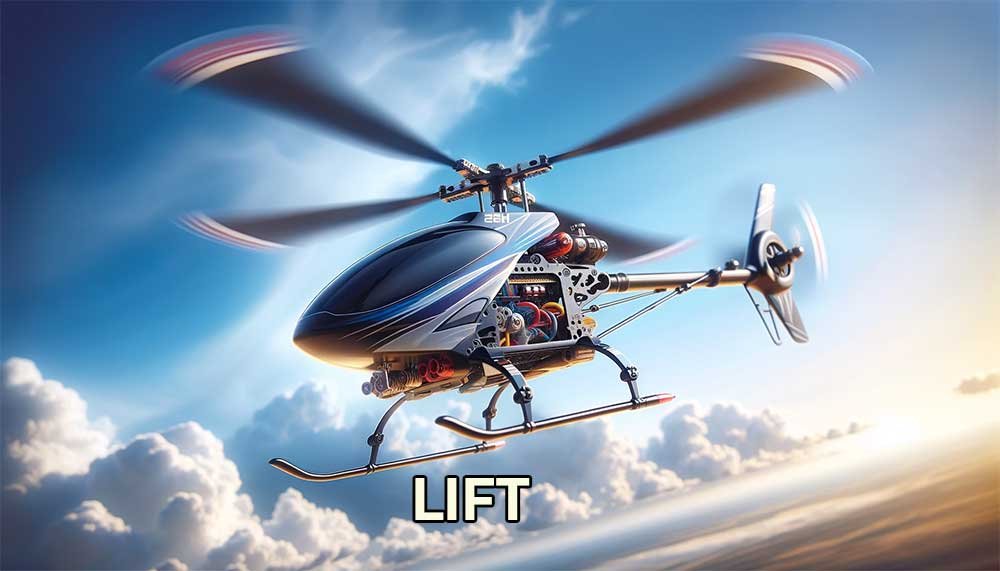
Key Components and Their Functions
An RC helicopter’s ability to fly, maneuver, and perform aerial tricks is a result of its complex design and the seamless integration of its components. Understanding these parts not only helps pilots with troubleshooting and maintenance but also with achieving better control and flight performance.
Main Rotor System
The main rotor system is the heart of the helicopter, responsible for creating lift and controlling movement. It consists of several blades that rotate around a central hub. The pitch of these blades can be altered to control lift and direction. The rotor’s speed and blade angle adjustments are crucial for takeoff, landing, and maneuvering.
Tail Rotor System
The tail rotor system counteracts the main rotor’s torque—preventing the body of the helicopter from spinning uncontrollably. It also plays a significant role in steering the helicopter by controlling its yaw, allowing the pilot to make precise turns.
Engine/Motor
The engine or motor powers the helicopter’s rotors. In electric RC helicopters, brushless motors are common due to their efficiency and power. Gas-powered models use internal combustion engines, which offer longer flight times but require more maintenance.
Control System
The control system is the bridge between the pilot and the helicopter, consisting of a transmitter, receiver, and servos. The transmitter is the remote control that the pilot uses to send commands, while the receiver interprets these commands and activates the servos. The servos, in turn, adjust the rotors’ pitch for direction and lift.
Flight Control Electronics
Modern RC helicopters often include advanced flight control electronics, such as gyroscopes and flight controllers. These components enhance stability and responsiveness, making it easier for pilots to maintain control, especially during challenging maneuvers or in windy conditions.
Battery and Power Distribution
In electric models, the battery is a critical component that determines the flight time and overall performance. The power distribution system ensures that energy from the battery is efficiently delivered to the motor, servos, and other electronic components.
The Importance of Regular Maintenance
Regular maintenance of these components is vital for the longevity and safety of RC helicopters. Checking for wear and tear, ensuring all parts are securely fastened, and keeping the helicopter clean can significantly impact its performance and reduce the risk of accidents.
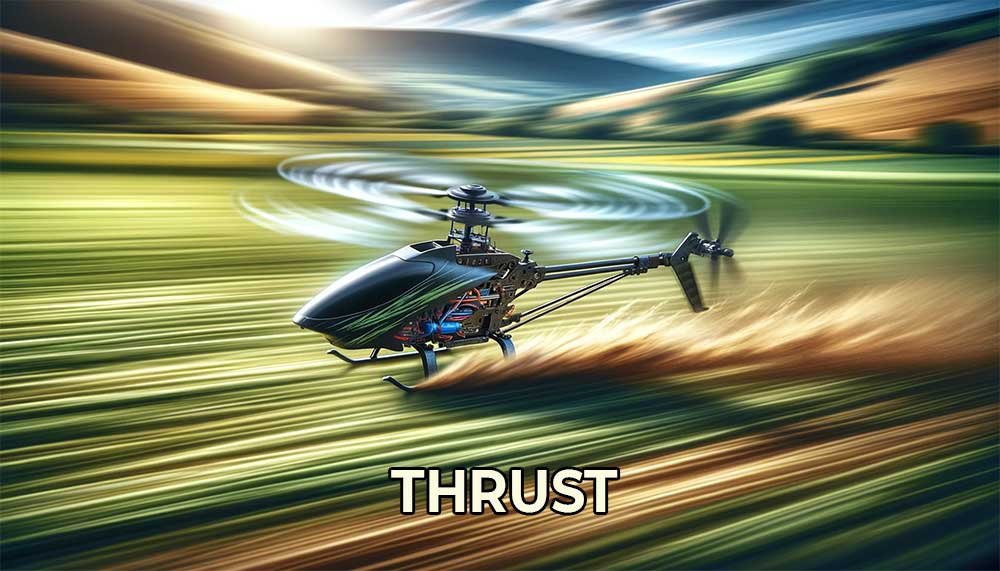
How Pilots Control RC Helicopters
Controlling an RC helicopter is a skillful art that combines technology, physics, and intuition. The pilot uses a transmitter, which sends signals to the receiver on the helicopter, manipulating its movements through a series of controls. Understanding these controls is crucial for mastering flight.
The Transmitter: Your Remote Control Interface
The transmitter is the pilot’s primary tool for communicating with the helicopter. It features several controls:
- Throttle Stick: Controls the rotor’s speed, affecting lift and altitude.
- Cyclic Stick: Tilts the rotor disk in different directions, controlling forward, backward, and side-to-side movement.
- Collective Pitch: Adjusts the angle of the rotor blades simultaneously, increasing or decreasing lift and thrust.
- Tail Rotor Control (Rudder): Manages yaw, allowing the helicopter to rotate left or right.
Advanced Control Features
- Gyroscopic Stabilization: Many transmitters work with onboard gyroscopes to stabilize the helicopter, especially in wind. This feature helps maintain orientation and makes hovering easier.
- Flight Modes: Some transmitters offer multiple flight modes, adjusting the helicopter’s responsiveness. Beginners may use a more stable mode, while advanced pilots can select a mode that offers more agility and faster responses.
Understanding the Flight Dynamics
Pilots must have a good understanding of how their inputs affect the helicopter’s behavior. For example, increasing the throttle without adjusting the collective pitch can lead to a rapid ascent, while combining throttle adjustments with cyclic inputs allows for smoother, controlled movements.
Practice and Precision
Mastering RC helicopter flight requires practice. Beginners often start with basic maneuvers, such as hovering and simple forward flight, before progressing to more complex movements. Simulators can be a valuable tool for practice without the risk of damaging a real helicopter.
Safety Considerations
Safety is paramount when flying RC helicopters. Pilots should always fly in designated areas, away from people and obstacles. Understanding and respecting the capabilities and limits of the helicopter can prevent accidents.

Advancements and Technologies in RC Helicopter Design
The world of RC helicopters has seen significant technological advancements over the years, pushing the boundaries of what these remarkable machines can achieve. From improvements in materials and power systems to the integration of sophisticated electronics, these advancements have made RC helicopters more accessible, durable, and exciting to fly.
Materials and Construction
Modern RC helicopters benefit from the use of advanced materials such as carbon fiber and lightweight metals. These materials not only reduce the overall weight of the helicopter, making it more efficient, but also increase its strength and durability. This has allowed for the design of helicopters that can withstand the rigors of advanced maneuvers and occasional crashes without significant damage.
Power Systems
The transition from nitro or gas-powered engines to electric motors has been a game-changer in the RC helicopter community. Electric helicopters are not only quieter and cleaner but also provide instant power delivery, which is crucial for precise control and performance. Advances in battery technology, such as Lithium Polymer (LiPo) batteries, have further enhanced the power-to-weight ratio, leading to longer flight times and more robust performance.
Flight Control and Stabilization Systems
One of the most significant advancements in RC helicopter technology is the development of advanced flight control and stabilization systems. Gyroscopes and accelerometers, once only found in professional-grade models, are now standard in many hobbyist helicopters. These systems help stabilize the helicopter, making it easier to fly and perform complex maneuvers. Some models even incorporate GPS for advanced positioning and autonomous flight capabilities.
Digital Communications and Controls
The evolution of digital communication technologies has greatly improved the interaction between the pilot and the helicopter. Digital transmitters offer more precise control, customizable settings, and the ability to update and program models for specific flight characteristics. This digital revolution has also facilitated the development of smartphone apps that can monitor flight data, adjust settings, and even control the helicopter in real-time.
The Future of RC Helicopter Flight
As technology continues to evolve, we can expect to see even more innovative features and capabilities in RC helicopters. Augmented reality (AR) and virtual reality (VR) technologies are beginning to find their way into the hobby, offering pilots immersive flying experiences. Additionally, advancements in artificial intelligence (AI) could lead to smarter, more autonomous helicopters capable of complex flight patterns and maneuvers with minimal input from the pilot.
Conclusion: The Sky’s the Limit
As we’ve explored the intricate mechanics, key components, and advanced technologies behind RC helicopters, it’s clear that this hobby offers a unique blend of challenges and rewards. From the basic principles of flight to the cutting-edge advancements in design and control, RC helicopters stand as a testament to human ingenuity and the relentless pursuit of aerial mastery.
Empowering Pilots of Tomorrow
The advancements in materials, power systems, and flight control technologies have not only made RC helicopters more accessible but also more appealing to a wider audience. Whether you’re a novice taking the controls for the first time or an experienced pilot executing complex maneuvers, the world of RC helicopters has something to offer everyone. The ongoing evolution of technology promises to further democratize this hobby, making it possible for pilots to achieve feats that were once deemed impossible.
A Community of Enthusiasts
At the heart of RC helicopter flying is a vibrant community of enthusiasts. From online forums and social media groups to local flying clubs, this community is a rich source of knowledge, support, and inspiration. Newcomers can find guidance, while seasoned pilots share their experiences and discoveries, pushing the boundaries of what can be achieved.
Looking Ahead
As we look to the future, the potential for innovation in RC helicopter design and functionality is boundless. With advancements in artificial intelligence, augmented reality, and other emerging technologies, the next generation of RC helicopters will offer even more immersive and intuitive flying experiences. These future developments will undoubtedly continue to captivate the imagination of pilots around the world, inviting more individuals to take to the skies and explore the thrilling world of RC helicopter flight.
The Journey Continues
The journey of understanding and mastering RC helicopters is ongoing. It’s a pursuit that combines technical skill, creativity, and a passion for flight. As technology advances, so too will the capabilities of these remarkable machines, offering endless possibilities for discovery and enjoyment. The sky, quite literally, is the limit.

Conclusion: The Sky’s the Limit
As we’ve explored the intricate mechanics, key components, and advanced technologies behind RC helicopters, it’s clear that this hobby offers a unique blend of challenges and rewards. From the basic principles of flight to the cutting-edge advancements in design and control, RC helicopters stand as a testament to human ingenuity and the relentless pursuit of aerial mastery.
Empowering Pilots of Tomorrow
The advancements in materials, power systems, and flight control technologies have not only made RC helicopters more accessible but also more appealing to a wider audience. Whether you’re a novice taking the controls for the first time or an experienced pilot executing complex maneuvers, the world of RC helicopters has something to offer everyone. The ongoing evolution of technology promises to further democratize this hobby, making it possible for pilots to achieve feats that were once deemed impossible.
A Community of Enthusiasts
At the heart of RC helicopter flying is a vibrant community of enthusiasts. From online forums and social media groups to local flying clubs, this community is a rich source of knowledge, support, and inspiration. Newcomers can find guidance, while seasoned pilots share their experiences and discoveries, pushing the boundaries of what can be achieved.
Looking Ahead
As we look to the future, the potential for innovation in RC helicopter design and functionality is boundless. With advancements in artificial intelligence, augmented reality, and other emerging technologies, the next generation of RC helicopters will offer even more immersive and intuitive flying experiences. These future developments will undoubtedly continue to captivate the imagination of pilots around the world, inviting more individuals to take to the skies and explore the thrilling world of RC helicopter flight.
The Journey Continues
The journey of understanding and mastering RC helicopters is ongoing. It’s a pursuit that combines technical skill, creativity, and a passion for flight. As technology advances, so too will the capabilities of these remarkable machines, offering endless possibilities for discovery and enjoyment. The sky, quite literally, is the limit.
FAQs
FAQ1: How do RC Helicopters Fly?
- RC helicopters fly by balancing lift, weight, thrust, and drag.
- Lift is created by the rotor blades spinning, which allows the helicopter to rise.
FAQ2: What are the Main Components of an RC Helicopter?
- Main components include the rotor system, engine/motor, control system, and battery.
- Each part plays a crucial role in the helicopter’s flight and maneuverability.
FAQ3: What Technological Advancements are Seen in RC Helicopters?
- Advancements include the use of lightweight materials and electric motors.
- Modern RC helicopters feature advanced flight control and stabilization systems.
You May Also Like
Related Posts
RC ERA C129 V2 Review: What Makes It Stand Out
Explore the RC ERA C129 V2’s advanced features, its suitability for beginners, and how it’s revolutionizing remote-controlled flight.
Why Choose RC ERA C187 for Your Hobby
Explore the exciting world of the RC ERA C187 Helicopter. This guide offers tips, reviews, and techniques for beginners and pros alike.
RC ERA C127AI Review: Tech Specs and User Feedback
Explore the revolutionary RC ERA C127AI with advanced tech, user-friendly features, and expert reviews. Learn why it’s the top choice for RC enthusiasts.
More Models
RC ERA C129 V2 Review: What Makes It Stand Out
Explore the RC ERA C129 V2’s advanced features, its suitability for beginners, and how it’s revolutionizing remote-controlled flight.
Why Choose RC ERA C187 for Your Hobby
Explore the exciting world of the RC ERA C187 Helicopter. This guide offers tips, reviews, and techniques for beginners and pros alike.
RC ERA C127AI Review: Tech Specs and User Feedback
Explore the revolutionary RC ERA C127AI with advanced tech, user-friendly features, and expert reviews. Learn why it’s the top choice for RC enthusiasts.

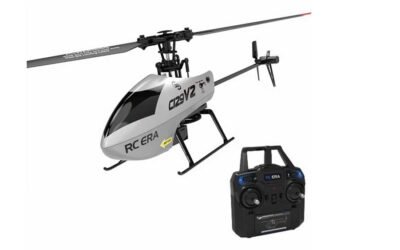
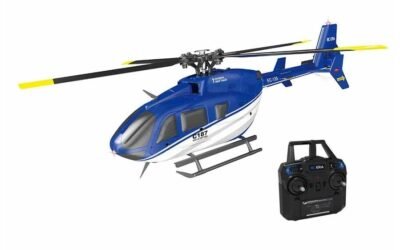
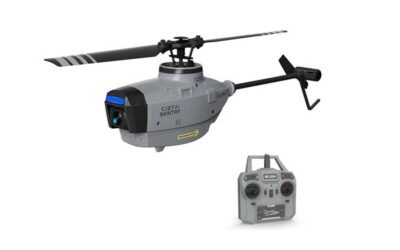
0 Comments